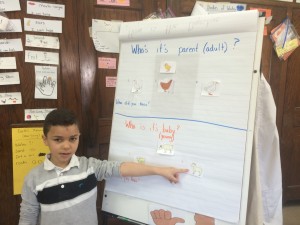Week of April 11-15
Kindergarten:
Content Objective: I can demonstrate comprehension of Earth’s materials by observing and comparing sand and rocks using a magnifying glass, tweezers, and screens.
Language Objective: I can draw and label my sand sample.
Vocabulary: Earth Material, non-living, sand, rocks, pebbles, magnifying glass
E.SE.00.11 Identify Earth materials that occur in nature(sand, rocks, soil, water).
First Grade:
Content Objective: I can demonstrate knowledge of animal life by matching adult(parent) and baby(young) animals and recognizing which characteristics are similar and which are different.
Language Objective: I can draw and write to compare how an adult and baby animal are alike and different.
Vocabulary: parent, adult, young, baby, characteristics, compare, traits
L.HE.E.1 Observable Characteristics-Plants and animals share many, but not all, characteristics of their parents.
L.HE.01.11 Identify characteristics(for example: body covering, beak shape, number of legs, body parts) that are passed on from parents to young.
L.HE.01.12 Classify young animals based on characteristics that are passed from parents(for example: dog/puppy, cat/kitten, cow/calf, chicken/chicks…)
Second Grade:
Content Objective: I can demonstrate knowledge of parts of a plant by recognizing and sorting various foods as parts(seed, root, stem, leaves, flower) of a plant.
Language Objective: I can write to explain my experience in recognizing and eating plant parts.
Sentence Stems:
Today I ate a whole plant! The parts of the plant I liked best were______________. The parts of the plant I did not like were__________________________.
Vocabulary: parts, plant, seed, root, stem, leaves, flower, physical characteristics
L.HE.02.13 Identify characteristics of plants.
L.HE.E.1 Observable characteristics- Plants share many, but not all, characteristics of their parents.
Third Grade:
Content Objective: I can demonstrate comprehension of Earth’s natural resources by observing soil, sand, rocks, and clay using a magnifying glass and creating a list of what these materials are used for.
Language objective: I can write to explain what Earth materials are used for using sentence stems:
Soil is used to make_____________.
Sand is used for __________________.
Rocks are used to make _________________________.
Clay is used for_______________________.
Vocabulary: Earth material, sand, water, soil, rocks, clay, natural resources
E.SE.03.13 Recognize and describe different types of Earth materials(mineral, rock, clay, sand, soil).
E.SE.03.31 Identify Earth materials used to construct some common objects(bricks, buildings, roads, glass)
Fourth Grade:
Content Objective: I can demonstrate comprehension of the requirements and needs of plants and animals by observing and comparing a real plant and animal(crickets) focusing on their structures and needs for survival.
Language Objective: I can write to explain at least 3 ways that my group compared a plant and animal using my venn diagram and sentence stems:
Animals and plants both have ______________________.
Animal and plants both need_________________________.
Animal and plants are different __________________________.
Vocabulary: plants, animals, needs, relationship, requirements, compare, different, organisms, survival, part
L.OL.E.1 Life Requirements- Organisms have basic needs. Animals and plants need air, water, and food. Plants also require light. Plants and animals use food as a source of energy and as a source of building material for growth and repair.
L.OL.04.15 Determine that plants require air, water, light, and a source of energy and building material for growth and repair.
L.OL.04.16 Determine that animals require air, water, and a source of energy and building material for growth and repair.
Fifth Grade:
Content Objective: I can demonstrate knowledge of the Digestive system by experimenting in a hands on digestive system activity that shows the parts involved and how they work together to make the system work.
Language Objective: I can write to explain how the parts(organs) of the Digestive System work together to form a functioning system.
Sentence stem:
The Digestive System works as a system by ___________________________________________.
Vocabulary: system, Digestive, parts, organs, function, mouth, teeth, saliva, tongue, esophagus, stomach, acid, small intestine, large intestine, liver pancreas
L.OL.05.41 Identify the general purpose of selected animal systems.
L.OL.M.4 Animal systems- Multicellular organisms may have specialized systems that perform functions which serve the needs of the organism.
![IMG_3618[1]](https://iblog.dearbornschools.org/gruczl/wp-content/uploads/sites/1011/2016/04/IMG_36181-300x225.jpg)
![IMG_3617[1]](https://iblog.dearbornschools.org/gruczl/wp-content/uploads/sites/1011/2016/04/IMG_36171-300x225.jpg)
![IMG_3614[1]](https://iblog.dearbornschools.org/gruczl/wp-content/uploads/sites/1011/2016/04/IMG_36141-300x225.jpg)
![IMG_3613[1]](https://iblog.dearbornschools.org/gruczl/wp-content/uploads/sites/1011/2016/04/IMG_36131-300x225.jpg)

![IMG_3632[1]](https://iblog.dearbornschools.org/gruczl/wp-content/uploads/sites/1011/2016/04/IMG_36321-300x225.jpg)
![IMG_3630[1]](https://iblog.dearbornschools.org/gruczl/wp-content/uploads/sites/1011/2016/04/IMG_36301-300x225.jpg)
![IMG_3641[1]](https://iblog.dearbornschools.org/gruczl/wp-content/uploads/sites/1011/2016/04/IMG_36411-300x225.jpg)
![IMG_3639[1]](https://iblog.dearbornschools.org/gruczl/wp-content/uploads/sites/1011/2016/04/IMG_36391-300x225.jpg)
![IMG_3637[1]](https://iblog.dearbornschools.org/gruczl/wp-content/uploads/sites/1011/2016/04/IMG_36371-300x225.jpg)
![IMG_3635[1]](https://iblog.dearbornschools.org/gruczl/wp-content/uploads/sites/1011/2016/04/IMG_36351-300x225.jpg)
![IMG_3633[1]](https://iblog.dearbornschools.org/gruczl/wp-content/uploads/sites/1011/2016/04/IMG_36331-300x225.jpg)
![IMG_3603[1]](https://iblog.dearbornschools.org/gruczl/wp-content/uploads/sites/1011/2016/04/IMG_36031-300x225.jpg)
![IMG_3601[1]](https://iblog.dearbornschools.org/gruczl/wp-content/uploads/sites/1011/2016/04/IMG_36011-300x225.jpg)
![IMG_3600[1]](https://iblog.dearbornschools.org/gruczl/wp-content/uploads/sites/1011/2016/04/IMG_36001-300x225.jpg)
![IMG_3599[1]](https://iblog.dearbornschools.org/gruczl/wp-content/uploads/sites/1011/2016/04/IMG_35991-300x225.jpg)
![IMG_3598[1]](https://iblog.dearbornschools.org/gruczl/wp-content/uploads/sites/1011/2016/04/IMG_35981-300x225.jpg)
![IMG_3597[1]](https://iblog.dearbornschools.org/gruczl/wp-content/uploads/sites/1011/2016/04/IMG_35971-300x225.jpg)
![IMG_3596[1]](https://iblog.dearbornschools.org/gruczl/wp-content/uploads/sites/1011/2016/04/IMG_35961-300x225.jpg)
![IMG_3595[1]](https://iblog.dearbornschools.org/gruczl/wp-content/uploads/sites/1011/2016/04/IMG_35951-300x225.jpg)
![IMG_3593[1]](https://iblog.dearbornschools.org/gruczl/wp-content/uploads/sites/1011/2016/04/IMG_35931-300x225.jpg)
![IMG_3592[1]](https://iblog.dearbornschools.org/gruczl/wp-content/uploads/sites/1011/2016/04/IMG_35921-300x225.jpg)
![IMG_3591[1]](https://iblog.dearbornschools.org/gruczl/wp-content/uploads/sites/1011/2016/04/IMG_35911-300x300.jpg)
![IMG_3604[1]](https://iblog.dearbornschools.org/gruczl/wp-content/uploads/sites/1011/2016/04/IMG_36041-300x225.jpg)
![IMG_3605[1]](https://iblog.dearbornschools.org/gruczl/wp-content/uploads/sites/1011/2016/04/IMG_36051-300x225.jpg)
![IMG_3606[1]](https://iblog.dearbornschools.org/gruczl/wp-content/uploads/sites/1011/2016/04/IMG_36061-300x225.jpg)
![IMG_3607[1]](https://iblog.dearbornschools.org/gruczl/wp-content/uploads/sites/1011/2016/04/IMG_36071-300x225.jpg)
![IMG_3609[1]](https://iblog.dearbornschools.org/gruczl/wp-content/uploads/sites/1011/2016/04/IMG_36091-300x225.jpg)
![IMG_3610[1]](https://iblog.dearbornschools.org/gruczl/wp-content/uploads/sites/1011/2016/04/IMG_36101-300x225.jpg)
![IMG_3612[1]](https://iblog.dearbornschools.org/gruczl/wp-content/uploads/sites/1011/2016/04/IMG_36121-300x225.jpg)
Leave a Reply